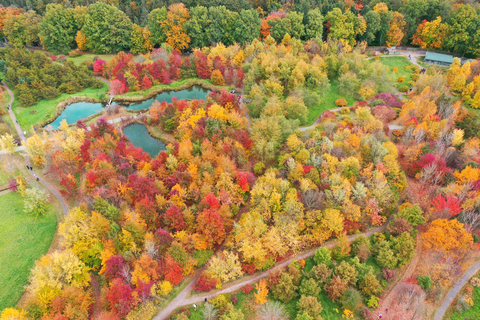06.12.2023
20 Jahre Nordamerika im ForstPark Tharandt – ein einzigartiges Reallabor für Waldbau in Zeiten des Klimawandels
Der Forstbotanische Garten der TU Dresden in Tharandt feiert in diesem Jahr ein besonderes Jubiläum: Vor 20 Jahren, im Frühjahr 2003 wurde auf einem 15 Hektar großen Gelände das Quartier der nordamerikanischen Wälder angelegt. Zunächst waren auf der Fläche ein Wegenetz sowie Teiche, die die Great Lakes und den Großen Salzsee symbolisieren, und Felsen als Rocky Mountains und Appalachen gestaltet worden. Mit den anschließenden ersten Pflanzungen konnte auch die Öffentlichkeit den neuen Park betreten. Interessierte sollten die Entstehung und Entwicklung von Beginn an mitverfolgen können.
Seitdem wurden an 13.000 Pflanzplätzen rund 40.000 Pflanzen, Bäume und Sträucher, ausgebracht. Sie stammen alle vom Naturstandort in Nordamerika und wurden meist von Mitarbeitenden des Forstgartens vor Ort als Saatgut gesammelt und im Gewächshaus und der Baumschule des Forstgartens angezogen. Um bestmögliche Forschungsbedingungen zu schaffen, wurden von allen bisher vertretenen 500 Arten der nordamerikanischen Gehölzflora zahlreiche Individuen ausgebracht, die teils aus unterschiedlichen Regionen ihres Verbreitungsgebiets gesammelt wurden.
Im ForstPark mit seinen 42 Quartieren sind die unterschiedlichen Waldtypen Nordamerikas nachgebildet: die Nadelwälder des Westens finden sich ebenso wie die Laubwälder des Ostens. In den jeweiligen Waldtypen sind die Baum- und Straucharten gemäß ihrem Vorkommen am Naturstandort in artenreichen Mischbeständen arrangiert. Daten dazu wurden während der Sammelreisen gewonnen und mit Beschreibungen in der Literatur abgeglichen.
Ziel des Projektes war und ist es, das Wachstum und die Entwicklung der nordamerikanischen Gehölzarten unter hiesigen klimatischen und standörtlichen Gegebenheiten zu erfassen und mit Blick auf die verschiedenen Nutzungsmöglichkeiten zu bewerten. Dabei geht es nicht nur um eine forstwirtschaftliche Nutzung zur Holzproduktion, sondern auch um den Einsatz als Stadt- und Straßengrün, in der Gartengestaltung, des Zierpflanzen- und selbst des Obstbaus. Gerade nordamerikanische Arten sind hier erprobenswert, da bereits viele in Mitteleuropa etabliert sind, wie zum Beispiel die Douglasie im Forst, der Amberbaum in der Stadt, die Schneebeere in vielen Gärten oder die Aronia im Obstbau. Es gibt aber noch zahlreiche weitere Arten, die zudem in Nordamerika zum Teil unter Klimaten gedeihen, die sich durch den Klimawandel auch in Mitteleuropa einstellen könnten. Sie gilt es zu finden und zu erproben.
Da die Arten im ForstPark in ausreichender Stückzahl und aus unterschiedlichen Provenienzen ihres Verbreitungsgebietes angepflanzt wurden, bieten sie angemessene Stichprobengrößen und Vergleichsmöglichkeiten für verschiedene Untersuchungen. Bisher wurde der Fokus vor allem auf Wachstumsparameter gelegt: Höhen- und Durchmesserwachstum, Vergleiche zwischen Arten und Provenienzen oder die Reaktion auf Witterungsereignisse. Durch Grabungen und Bohrungen wird auch die Wurzelentwicklung beobachtet, die räumliche Ausdehnung des Wurzelsystems und damit die Erschließung des Bodens aber auch die Standfestigkeit beurteilt. Dabei erfassen die Wissenschaftler:innen auch, ob sich Arten womöglich unkontrolliert ausbreiten und zu Schäden führen können.
Die Datenerhebungen erfolgten bisher vor allem aufgrund studentischer Abschlussarbeiten und sollen in den Folgejahren kontinuierlich fortgesetzt werden, auch im Rahmen von Drittmittelprojekten, um aussagekräftige Zeitreihen zu generieren. Nach einer ersten Etablierungsphase des ForstParks wurde ab 2010 mit den Erhebungen begonnen. Seitdem sind 45 Bachelor- und sechs Masterarbeiten entstanden.
Mit der Nachfolge von Prof. Bernhard Schuldt auf Prof. Andreas Roloff auf dem Direktorenposten des Forstbotanischen Gartens im Oktober 2022 sollen die bisherigen Untersuchungen vor allem durch physiologische Analysen ergänzt und erweitert werden. Aufgrund der Zunahme an Dürreereignissen ist die Unterstützung des Waldumbaus hin zu klimaresilienten Beständen eine der dringlichsten Aufgaben der Forstwissenschaften. Auch wenn aktuell vor allem Mischwälder mit heimischen Laubbaumarten bevorzugt werden, bietet der ForstPark mit seiner beachtlichen Anzahl an Baumarten aus Nordamerika nach 20 Jahren Etablierungsphase ideale Bedingungen zur vergleichenden Erforschung der Trockentoleranz von Baumarten der kühlgemäßigten Klimazone. Hierfür werden entscheidende artspezifische Eigenschaften auf Holz- und Blattebene, die im direkten Zusammenhang mit der Resistenz gegenüber Wassermangel stehen, im Labor erfasst und beschrieben. Zusätzlich soll an ausgewählten Bäumen der Wasserverbrauch mit im Stamm installierter Sensorik erfasst werden. Diese Untersuchungen werden durch Messungen der Wasserabgabe der Blätter unterstützt, wobei ein Zugang zur obersten Baumkrone durch einen Hubsteiger möglich ist. Drohnenbasierte Messungen des Kronenwasserzustands vervollständigen diese Daten. Aufgrund der weltweit festgestellten Zunahme an Baum- und Waldsterbeereignissen in Folge von Dürre besteht international ein großes Interesse am Verständnis der Trockenheitsantwort von Bäumen. Der ForstPark in Tharandt wird hierzu einen wesentlichen Beitrag leisten können.
Der ForstPark und seine Forschungen im Video: Gebietsfremde Bäume als Antwort auf den Klimawandel
Die Auswirkungen des Klimawandels auf den Wald im Video: Wie sieht die Zukunft des Waldes aus?
Kontakt:
Forstbotanischer Garten Tharandt / Sächsisches Landesarboretum

